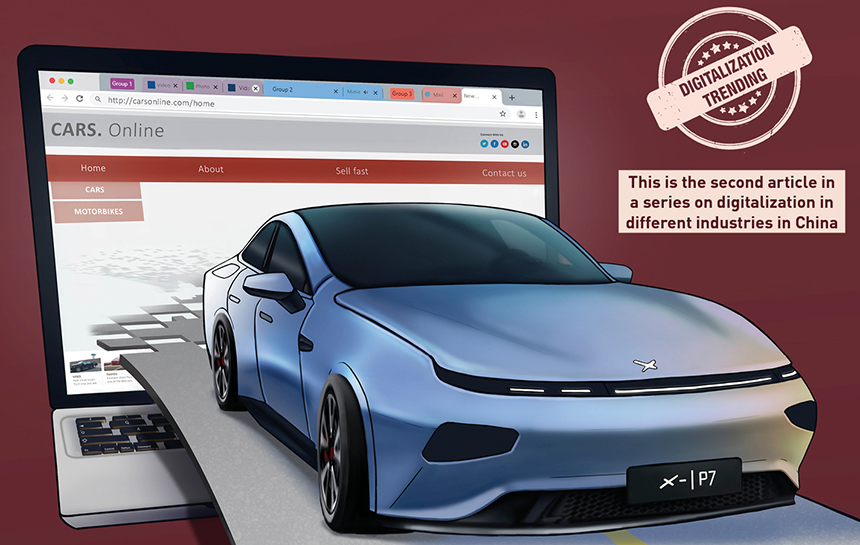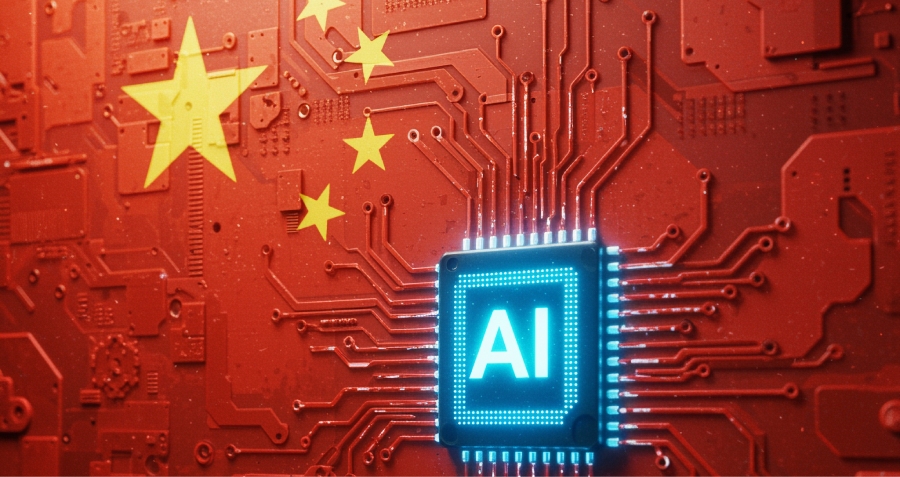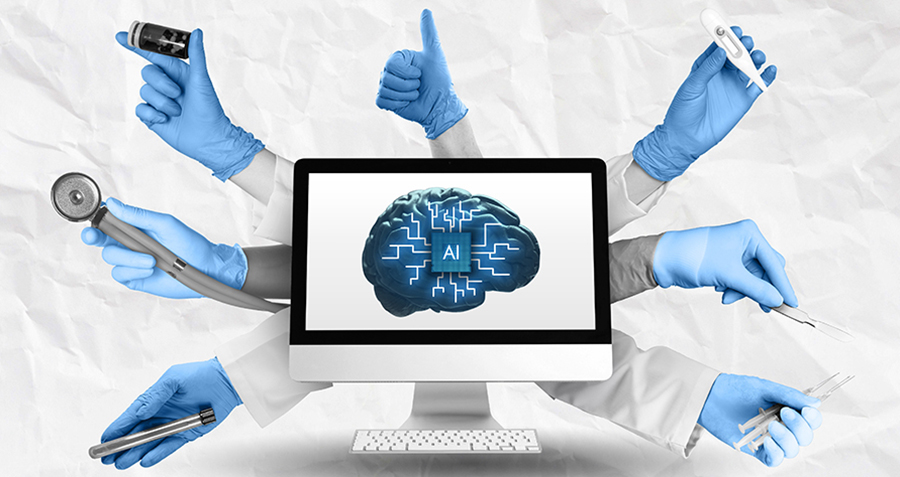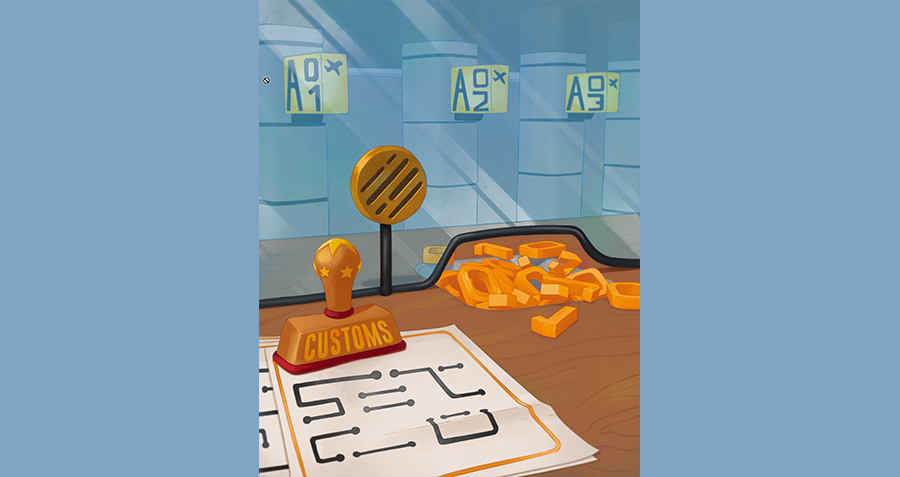Digitalization is transforming the traditional face-to-face sales and marketing aspect of the auto industry.
This is the second article in a series on digitalization in different industries in China. The first article, on the digitalization of China’s manufacturing sector, can be found in the August 2021 edition of CKGSB Knowledge
IT worker Jefferson Teng fits the stereotype of the customer the new Chinese electric vehicle (EV) startups seek to attract. The Hangzhou resident is an avid car fan in his late twenties, regularly taking new models out for test drives.
“[I never quite understood] how the traditional car industry was moving so slowly each year with each model having a tiny improvement on this part or that part, yet claiming to be ‘the brand new 2020 model that promises to change your life!’ in the ads,” says Teng.
But now Teng’s opinion has changed. The new China manufacturers are offering vast improvements in vehicle technology with each iteration. And interestingly, this includes what amounts to a revolution in all aspects of car ownership, reflecting the rapid digitalization of the Chinese auto industry as a whole.
In 2020, Teng was one of the first people to buy the XPeng P7, a mid-sized electric sedan which quickly generated a lot of buzz. “It has a very innovative and bold exterior design, and one of , if not the best, or ‘autonomous’ driving systems right now on the market, at least for Chinese roads. Plus [it has] the most powerful voice command system,” he explains.
Tesla might be the internationally known trailblazer, but in China there are startups such as Li Auto, NIO and XPeng that are changing the very nature of the car into something totally digital.
Digital ignition
Until recently, the whole ecosystem of car purchase and ownership in China, just like everywhere else, had been basically analogue—face-to-face and offline. But now, China’s digital natives are starting to feel more at home because the auto industry is digitalizing at a speed that is hard for some other industries to keep pace with.
“Manufacturers are struggling with the very concept of building vehicles equipped to be digital services platforms. Smart device technologies are rooted in electronics and software technology where development cycles tick at a faster rate than the mechanically engineered car,” says Bill Russo, CEO of Automobility, a mobility strategy consulting and investment platform.
But digitalization isn’t a completely alien concept to the car original equipment manufacturers (OEMs)—companies that build car parts or entire vehicles that are used by carmakers. The majority of carmakers are their own OEM with the exception of NIO and, until recently, XPeng which used contract manufacturers. For the OEMs, digitalization is a process that has happened over decades but has largely been felt in R&D.
“With R&D and production the transition has been happening for more than two decades, computer assisted engineering (CAE) has been implemented in the R&D processes everywhere,” explains Sa Boni, Director of China Automotive at IHS Markit. Where traditional carmakers struggle is extending digitalization over the complete ecosystem beyond just manufacturing and into interactions between the company, the car and the consumer. Such interactions are blurring traditional boundaries that exist between the nature of the car, marketing and sales, maintenance and updating, along with the overall consumer experience.
“Automakers are struggling to pivot their companies, employees, policies and processes to this move to digital. Many of their current employees don’t have the necessary skills that are needed to be successful in a digital world,” says Tu Le, Managing Director of Sino Auto Insights. While Le says OEMs might talk the talk in front of the media, he warns that behind closed doors they often suffer intense inertia and power struggles that can threaten the stability of the business. Meanwhile, the need for change is accelerating.
Car specifications
Traditionally automotive OEMs have operated on a business-to-business (B2B) basis. They designed and engineered cars for parameters like safety, performance and style before manufacturing them and selling them to dealers. Although the end user was important, there was no direct contact. Also, once the car owner bought the car, there might not even be any contact between them and the dealer—although in China, thanks to the 4S model—a full-service approach that brings together sales, service, spare parts and surveys (customer feedback)—retention has been much better, with customers returning to dealerships for as long as their warranty lasts. Crucially, from the moment of manufacture, the car’s capabilities would not change unless the owner modified it, something done by a small minority. Smart EVs, from the startups, have smashed these barriers.
“Automakers now need to master two worlds: hardware and software, with the software part gaining importance,” says Christoph Weber, China GM of AutoForm, a software development company that specializes in sheet metal forming for car parts. “In the software world, products are developed with agile methodologies in order to deliver product iterations in a matter of weeks. In the hardware world however, [which is] bound to heavy investments, e.g., for stamping tools and welding robots, OEMs still work in traditional project management waterfall phases with product development cycles of 2-4 years.” He goes on to say that, “several OEMs have launched transformation projects to connect departments on digital platforms in order to increase agility also in the traditional manufacturing disciplines.” Such discrepancies cause obvious challenges.
Exacerbating the problem is the switch to EVs. “EVs have fewer parts than their internal combustion engine counterparts so that means that there would need to be fewer people, smaller factories, fewer jobs up and down the supply chain,” says Le. Legacy companies essentially have too many of the wrong kind of employees and reskilling them might not be possible.
Weber feels that legacy OEMs have a problem punching through the hierarchies built up to work holistically across departments. The new Chinese startups, on the other hand, have been able to build new organizations from the ground up with an emphasis on digitalization.
Car manufacturing has, for a long time, been about putting together components, usually produced by suppliers. But with digitalization, the car is becoming less of the product and like with social media the consumer is becoming the product—data collected from the consumer can be sold on to other firms. In most industries it is common for brands to contract out manufacturing but in the automotive industry in China, NIO is an outlier for not owning a factory.
“NIO’s openness to digital tools and cooperation with strong partners from traditional and new industries has allowed them to build a respected brand within only a very few years’ time,” adds Weber.
Death of the car salesman
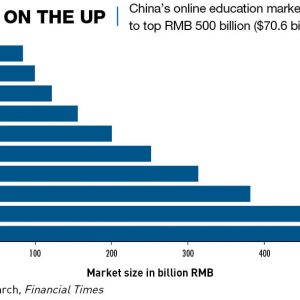
Historically, the 4S shops, usually located on the edge of the city, were the main point of contact for consumers as they offered a complete service that starts from the sale of the car and continues after purchase, with repairs for as long as the warranty is valid. In terms of marketing, the emphasis was on mass marketing channels such as TV or billboard advertising. “For modern consumers, particularly in China, speed, simplicity, convenience and interaction are the major drivers of decision behavior which car brands respond to in their marketing and sales efforts,” says Klaus Paur, Managing Patrner at MaLogic, a professional services firm that helps brands build value.
In China this has taken the form of small experiential shops, much like those of Apple, in upmarket malls. Chinese start-ups such as NIO and XPeng have copied this approach and legacy players, such as Shanghai Volkswagen, are also looking at this for their smart EV offerings.
Chinese startups all use apps to create high engagement with purchasers and potential purchasers and NIO’s app has 1.6 million registered users and boasts 200,000 daily users despite only having sold just over 100,000 cars. The NIO app contains an entire e-commerce and social media ecosystem alongside the car control functionality that it offers. Users can buy NIO-branded products and earn points through interactions that can be redeemed for NIO product-related rewards, the Chinese EV maker has even created NIO Houses which act as clubhouses for owners.
“The format of direct engagement with consumers of digital devices and associated services is a familiar and preferred model, especially for millennials and GenZ types who grew up with the convenience of smart devices. The car is an extension of their connected lifestyle,” explains Russo.
Direct engagement gives OEMs far more information about the consumer and also allows far more targeted marketing. Typically, customers start their purchase research online creating a digital trail. “Before digital marketing and customer engagement, it would have been much more difficult to measure the effectiveness of the billions of dollars spent each year on agencies and advertising, promotions and sponsorships but that’s given way to data analytics and optimization modeling,” says Le.
COVID accelerated some of the changes from the traditional 4S model, particularly with reduction of contact points. Geely, for example, started delivering keys to new cars by drone to avoid contact. Most analysts agree, though, that the traditional 4S model is not completely dead yet. The new model with experience centers works well when a brand has only two or three models, but not so well when there are 10, equally they tend to appeal more to the younger consumer base. “We should not forget that traditional car makers still earn their profits from conventional cars sold to the majority of customers, as opposed to new startups’ sales towards a comparably small share of early (technology) adopters. This transition from conventional to technology leader is a hugely difficult task!” says Paur. Ultimately, we are likely to see some sort of hybrid model between the old and new.
Fixing it
Last year XPeng did an OTA—over-the-air update—which increased the range of its P7 sedan by installing X-Pedal software to improve the car’s braking regeneration. In simple terms, this is how the car takes the energy wasted from the process of slowing down the vehicle and uses it to recharge the car’s batteries. The update required nothing from the car owners and was completed while many of them were asleep. Upgrading a car already sold to customers was near impossible until 2012 when Tesla finalized its OTA software.
Beyond simple updates, recalls are also relatively common in the automotive world for when parts are found to be defective and usually require customers to return cars to the dealer for repair—typically replacement of faulty parts. In June 2021, Tesla made headlines in China for a massive “recall” of 285,000 vehicles, except that the problem could simply be fixed by an OTA without customers having to return their cars.
“The OTA function means old vehicles can upgrade to the latest technology or features which will require OEMs to rethink the lifecycle of their vehicles and the resultant R&D process,” says Sa.
It is yet another step in the changing dynamics in the relationship with the end user. EVs with less moving parts already require less maintenance and OTA decreases the need for dealer visits even further. Where some legacy OEMs struggle is when they claim that cars have OTA capability but this needs to be done at the dealer.
Eventually though, cars do need physical maintenance, but even here the startups are changing the dynamic by using apps and collection services. “The owner of an EV can finish the maintenance service without going to the dealer with the staff picking up and returning the car to home like with NIO service,” says auto analyst David Zhang. Some cars can even place an order for replacement parts automatically when a service is completed.
Is the customer king?
The increasing digitalization of the auto industry means that data, rather than the customer, is the new king. Such digitalization from smart EV producers such as NIO and XPeng creates what Russo describes as “intelligent connectivity.” For producers it’s no longer about selling a vehicle to get consumers from A to B. “Deeply embedded smart vehicle technology is where we believe the battle for dominance of the future profit opportunity in the industry is fought and won,” explains Russo.
OTA allows the car to have evolving smart features and while for the consumer these help create an easier life and user experience, they also allow the OEM to learn a great deal of information about the user and their lifestyle. “Companies who own this data will be the beneficiaries of this development. This explains the massive investments of tech companies into new mobility,” says Paur.
Ownership of the data and its utility raise obvious ethical questions. Recent moves by the Chinese government show the desire to protect consumers more from the power of big tech companies and this will put boundaries on the evolution of the relationship. Russo sees the battle for this data currently being won by the smart EV producers, Tier 1 suppliers such as Banma and EcarX, along with smart device makers like Xiaomi and Huawei who are now muscling into the market particularly in partnership with legacy players.
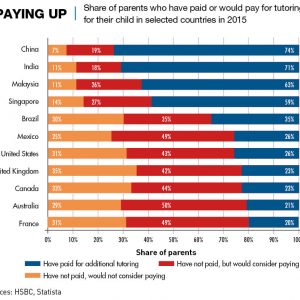
Much of the current data relates to areas such as the human-machine interface (HMI) through voice control, entertainment and navigation. However, this is shifting towards the vast amounts of data generated by the increasing number of sensors required in cars that are on the road to full autonomy. “The market for sensors, chips and systems for automated and autonomous driving is forecast to triple by 2030, with the sensor market reaching $40 billion and chip market reaching $30 billion. Automakers primarily only define the requirements and handle the vehicle integration. It will be mainly up to tier one suppliers such as Bosch and ZF together with chip manufacturers to design and manufacture the autonomous driving systems,” says Weber.
Freedom of the open road
Digitalization has already completely revolutionized the China auto industry from top to bottom, but this is still just the beginning and autonomous driving is set to change the environment even further. The industry measures autonomous driving on a scale of five where only level five is what the layman would consider to be autonomous driving—essentially a vehicle that can drive itself anywhere without any human input or even need for controls.
The best cars currently available for purchase have systems that equate to around level three, meaning that they can drive themselves in certain situations but require constant monitoring. Level 4 vehicles also already exist and are increasingly being utilized in geofenced areas for things like parcel delivery and as robotaxis. But the ability to implement autonomous driving is also constrained by current regulations and consumer acceptance, and when fully autonomous cars arrive, they are going to create existential questions about the nature of the car and the need for car ownership.
“The real long-term impact of autonomous driving vehicle must be the concept of mobility in the consumer’s mind. The mobility service offered by autonomous driving vehicle fleets can have a big impact on the willingness to own a car. As a result, traditional OEMs have to figure out if their customers will also be affected in the long future,” says Sa, adding that consumers benefit most when products are closest to their demands.
Autonomous driving is still a decade away, but China is certainly in the driver’s seat with the basics of the technology already present across the country. “Digitalization is not a differentiator, it’s a qualifier,” says Le. “This transition happens more easily and quickly in China due to the lack of legacy and history so China will be one of the leaders for sure.”




